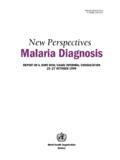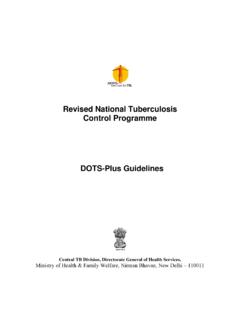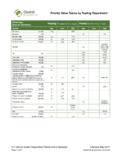Transcription of Drug resistance in malaria - who.int
1 WHO/CDS/CSR/ Drug resistance in malaria Peter B. Bloland World Health Organization Department of Communicable Disease Surveillance and Response This document has been downloaded from the WHO/CSR Web site. The original cover pages and lists of participants are not included. See for more information. WHO/CDS/CSR/ ORIGINAL: ENGLISH. DISTRIBUTION: GENERAL. Drug resistance in malaria Peter B. Bloland malaria Epidemiology Branch Centers for Disease Control and Prevention Chamblee, GA, United States of America World Health Organization TA OBI NT TEG FOR.
2 SIS CR E RA T. NC AL OF Y. RE IMI AINM L ST MEN. T T A U. AN CON LOB DOC. G D. FO WHO OUN. E R. E. T H AC KG. AB. R. Acknowledgement The World Health Organization wishes to acknowledge the support of the United States Agency for Inter- national Development (USAID) in the production of this document. World Health Organization 2001. This document is not a formal publication of the World Health Organization (WHO), and all rights are reserved by the Organiza- tion. The document may, however, be freely reviewed, abstracted, reproduced and translated, in part or in whole, but not for sale or for use in conjunction with commercial purposes.
3 The views expressed in documents by named authors are solely the responsibility of those authors. The designations employed and the presentation of the material in this document, including tables and maps, do not imply the expression of any opinion whatsoever on the part of the secretariat of the World Health Organization concerning the legal status of any country, territory, city or area or of its authorities, or concerning the delimitation of its frontiers or boundaries. Dotted lines on maps represent approximate border lines for which there may not yet be full agreement.
4 The mention of specific companies or of certain manufacturers' products does not imply that they are endorsed or recommended by WHO in preference to others of a similar nature that are not mentioned. Errors and omissions excepted, the names of proprietary products are distinguished by initial capital letters. Designed by minimum graphics Printed in Switzerland WHO/CDS/CSR/ DRUG RESISTANC IN malaria . Contents 1. Introduction 1. 2. Disease incidence and trends 2. Geographical distribution and populations at risk 2. Causative agents 3.
5 Diagnosis 3. Microscopy 3. Clinical (presumptive) diagnosis 3. Antigen detection tests 5. Molecular tests 5. Serology 5. Drugs available for treatment of malaria 5. Quinine and related compounds 5. Antifolate combination drugs 9. Antibiotics 9. Artemisinin compounds 9. Miscellaneous compounds 9. Combination therapy with antimalarials 10. Current status of drug-resistant malaria 10. 3. Causes of resistance 12. Definition of antimalarial drug resistance 12. malaria treatment failure 12. Mechanisms of antimalarial resistance 12.
6 Chloroquine resistance 12. Antifolate combination drugs 13. Atovaquone 13. Factors contributing to the spread of resistance 13. Biological influences on resistance 13. Programmatic influences on resistance 15. 4. Detection of resistance 16. In vivo tests 16. In vitro tests 17. Animal model studies 17. Molecular techniques 17. Case reports and passive detection of treatment failure 18. 5. Treatment 19. 6. The future: prevention of drug resistance 20. Preventing drug resistance 20. Reducing overall drug pressure 21. Improving the way drugs are used 21.
7 Combination therapy 21. iii DRUG resistance IN malaria WHO/CDS/CSR/ 7. Conclusions and recommendations 23. Priorities 23. 8. Bibliography 24. Figure and tables Figure 1. Approximate distribution of malaria 2. Table 1. Comparative descriptions of available malaria diagnostic methods 4. Table 2. Antimalarial drugs for uncomplicated malaria 6. Table 3. Distribution of drug-resistant Plasmodium falciparum malaria 10. iv WHO/CDS/CSR/ DRUG resistance IN malaria . 1. Introduction malaria remains an important public health of the greatest challenges facing malaria control concern in countries where transmission occurs today.
8 Drug resistance has been implicated in the regularly, as well as in areas where transmission has spread of malaria to new areas and re-emergence of been largely controlled or eliminated. malaria is a malaria in areas where the disease had been eradi- complex disease that varies widely in epidemiology cated. Drug resistance has also played a significant and clinical manifestation in different parts of the role in the occurrence and severity of epidemics in world. This variability is the result of factors such some parts of the world.
9 Population movement has as the species of malaria parasites that occur in a introduced resistant parasites to areas previously free given area, their susceptibility to commonly used of drug resistance . The economics of developing or available antimalarial drugs, the distribution and new pharmaceuticals for tropical diseases, includ- efficiency of mosquito vectors, climate and other ing malaria , are such that there is a great disparity environmental conditions and the behaviour and between the public health importance of the level of acquired immunity of the exposed human disease and the amount of resources invested in populations.
10 In particular, young children, developing new cures (1, 2). This disparity comes pregnant women, and non-immune visitors to at a time when malaria parasites have demonstrated malarious areas are at greatest risk of severe or fatal some level of resistance to almost every anti- illness. Many malaria control strategies exist, but malarial drug currently available, significantly none are appropriate and affordable in all contexts. increasing the cost and complexity of achieving malaria control and prevention efforts need to be parasitological cure.














